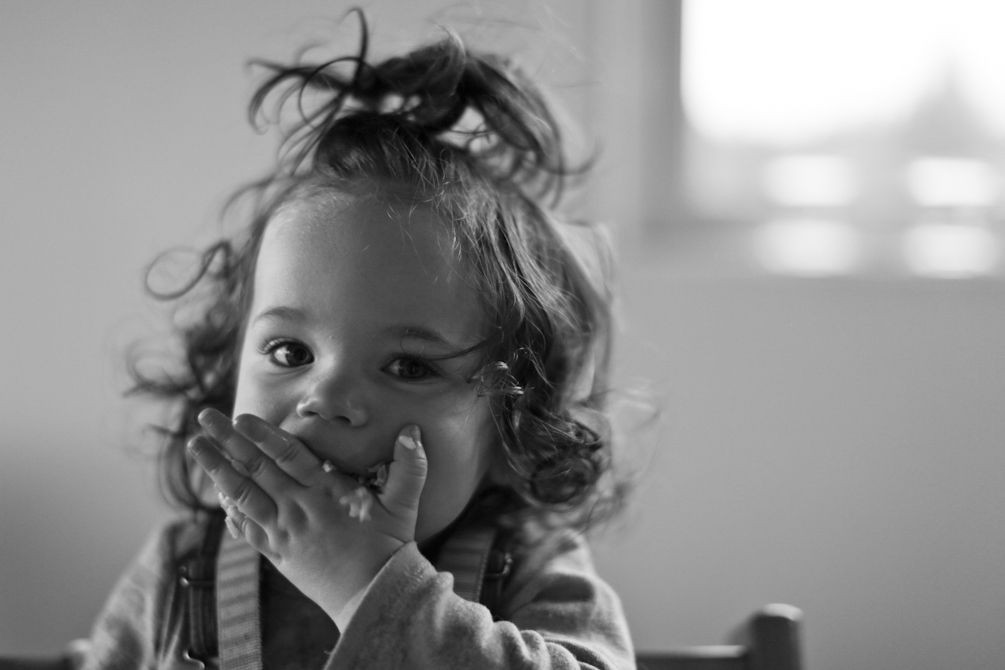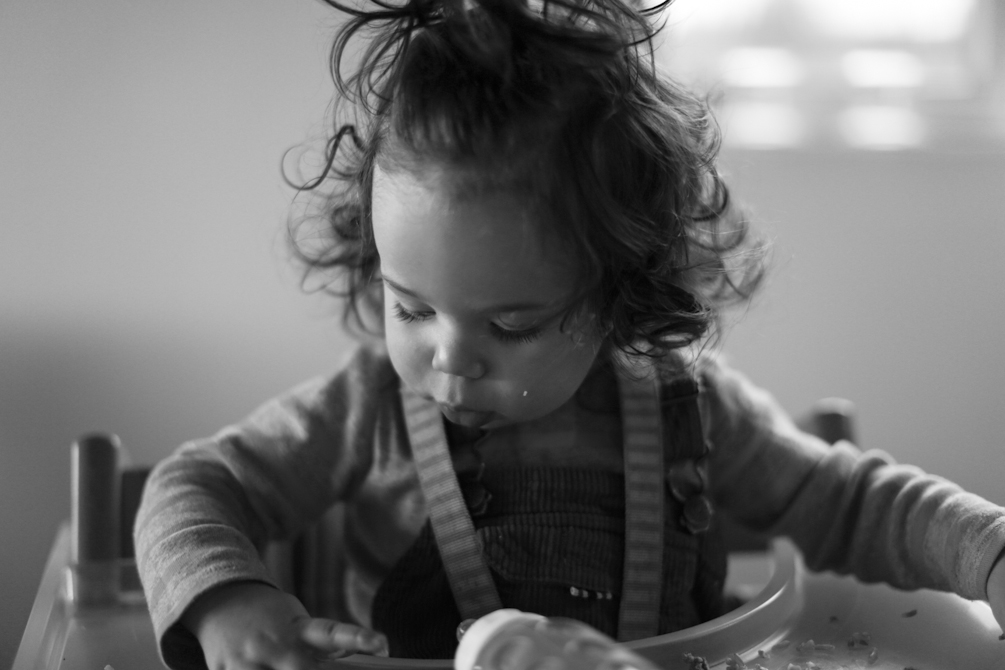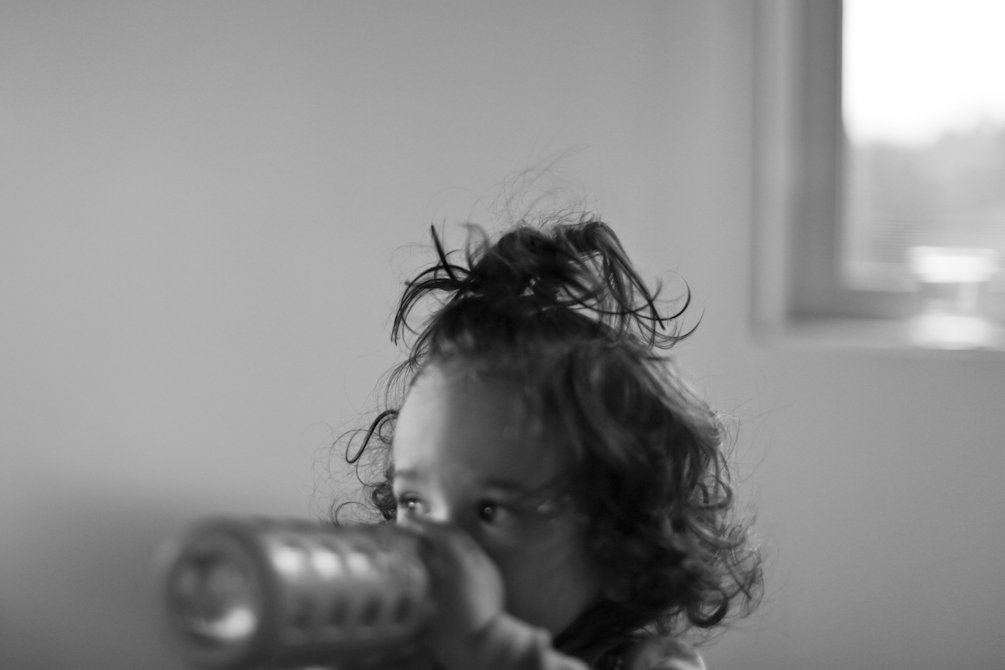In it together
First things first: if you don’t want to read about kid stuff, you should skip this post. I won’t mind. A few years ago, I totally would have skipped it. You have my permission, and my sympathy.
But if you, on the other hand, spent part of yesterday as I did, sitting on the floor with a sparkly child-size tulle skirt on your head, singing “Your Personal Penguin” to a small person while she sucked on a hank of her own hair, you might be at least somewhat interested in this post.
A few of you have written to ask if I would share my perspective on and approach to feeding kids. I’ve hemmed and hawed, mostly because the topic is fraught with mines and quicksand and very, very strong opinions. I am a new parent with a child who has only been eating solids for about six months. I am not an expert. No noooo NOOOOOOO. I am also keenly aware that my perspective would be different if my child or I had a food allergy or intolerance, or if my child were very picky. What I’m trying to say is: my perspective doesn’t mean much.
That said, I know that I really enjoy reading about other parents’ approaches to feeding their kids. I find it helpful. Sometimes stressful, but often helpful, insightful, and even galvanizing. Maybe you find it helpful, too? So, maybe, if I do write a bit about my approach to feeding June, we can all agree to stay cool about it and understand that I do not claim to know anything about any child but my own?
To be honest, I try not to think too hard. I assume that if June is getting some fruits, some vegetables, some fat, and some protein most days, she’s going to be all right. Ever since she was born, I’ve had this sense – I can’t explain it without sounding all new-age-y and annoying; get out your crystals, folks! – that June is going to be okay. That goes generally, across the board. I hope I never have to second-guess it. When it comes to feeding her, I try to avoid any guidelines or quantities, because they keep me up at night. The way I see it, my job is to offer a reasonable variety of foods, the kind of stuff that Brandon and I eat, and June’s job is to choose which parts to eat and how much. I don’t cajole when she doesn’t want to eat, and I don’t praise her when she does. Sometimes she eats like a pack of wild dogs, and sometimes, like tonight, she eats only a few bites. I’m sure that there are many picky moments to come, and maybe even picky weeks, months, or years. If there is one thing that I am trying to remember in my young career as a parent, it’s that whatever is true today may not be true tomorrow. And I want food to be something fun that we can share, not a source of strife. I have to lay the foundations for that.
My approach to feeding June has been shaped in large part by two people: my friend Matthew Amster-Burton, author of Hungry Monkey, and Nina Planck, author of Real Food for Mother and Baby. (I read the latter while I was pregnant, and it also had a big impact on how I decided to eat during pregnancy, and how I eat now.) For me, the big take-away from Matthew’s book is this: there is no such thing as baby food. And that dovetails nicely, I think, with Nina Planck’s viewpoint, which is roughly this: Whole foods are best. Cereals are not great first foods, because babies’ bodies aren’t able to break down complex starches. Babies need fat and protein. And mostly, babies – and mothers – need good, simple food.
June tasted her first solid food around five months, when I let her suck on some raw apple that I had sliced for myself. I also gave her tastes of my favorite whole-milk plain yogurt, parsnip soup, split pea soup, avocado, pizza crust, chana masala, and a bunch of other foods from our plates. Neither Brandon nor I have food allergies, and our doctor was pretty laid-back on the topic of first foods. He suggested that we be careful with citrus and strawberries, which apparently can cause reactions, but otherwise, he explained that the guidelines for first foods change so often that it’s hard for him to get strongly behind any of them. As it happened, June wasn’t really interested in solids until she was about 10 months old, at which point she had teeth and could handle a decent variety of textures. Over a couple of months, she started eating more “real” meals and nursing less. I introduced her to whole cow’s milk when she was just under a year old, and I weaned her from the breast completely about a month ago, at 15 months.
I salt June’s food as we salt our own. I try not to give her a lot of sweet things – not because I think I can mold her into a non-sweets-craving person (haa haaaa, RIIIIIIIIIGHT), but mostly because I know she will want to eat the living crap out of them, and I want her to save room for other things. I would like her to grow up understanding that there is no such thing as bad food: that some foods are better for our bodies, yes, and some food isn’t food at all (like Nerds and sour gummies, both of which I would currently kill for), but that there is time enough for all of it. I want her to know that food is about pleasure and connection and sustenance.
Sometimes she eats everything we give her. Other times, she won’t touch something that she loved only the day before. Sometimes she throws her food on the floor. Sometimes she feeds it to Alice. Sometimes she feeds it to us. Sometimes she spits it out and plays with it and then puts it back in her mouth and eats it. In any case, I try not to respond. I don’t try to make her eat. If she can feed herself, I let her. She’s in charge of how much she eats. She knows a few signs – food, water, milk, more, please – and she can tell me when she is hungry or thirsty. I try not to hover or push or freak out. I try. I really try.
So far, June’s favorite foods are milk, fruit, and meat. She would probably drink milk and eat bananas and brisket all day, if I let her. But she also loves Hugo’s pastina, any meat that’s fall-apart tender, scrambled eggs, cold pepperoni, Brandon’s pizza, pasta with our friend Francis Lam’s eggplant sauce, Cafe Lago meatballs, ham bone soup, pasta with Bolognese, French fries, prosciutto, a cannellini bean and lamb soup that Lecia made, and Ed Fretwell Soup from my first book. I try to always keep peas in the freezer and a roasted sweet potato in the fridge, and when I can, I make a big batch of homemade applesauce. At the end of summer, she was way into berries, and somewhat into roasted zucchini. Lately, she’s into roasted Brussels sprouts, slightly mushy steamed broccoli, and oranges. She likes rice and beans, and pho. Most mornings, she eats whole-milk plain yogurt and fruit, or some oatmeal. Yesterday, we had oatmeal pancakes – which, when cold, also make a good midday snack with a slice of cheddar cheese. For dessert, she’s a big fan of graham crackers, or half a banana and some peanut butter. We offer her water with every meal – from a cup, a cup with a straw, or a bottle; whatever is around – and we save milk for first thing in the morning, naptime, and bedtime, or else she fills up. I think June would want me to add, just for the sake of completeness, that she is not a fan of avocado, fish, or seafood. And she refuses to swallow any kind of winter squash. She likes bread, but so far only as a toy. And that is the truth according to June on this day, January 15, 2014.
I hope this is helpful? Or, at least, I hope this didn’t make you feel like I feel, which is to say, totally preoccupied with getting your hands on some sour gummies? Either way, I guess we’re in it together. xx





